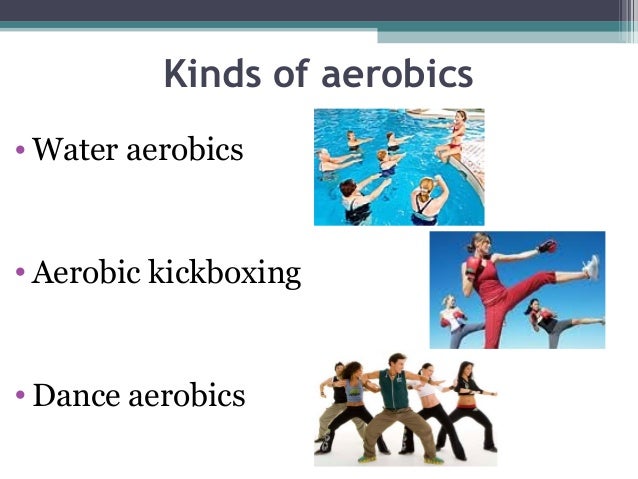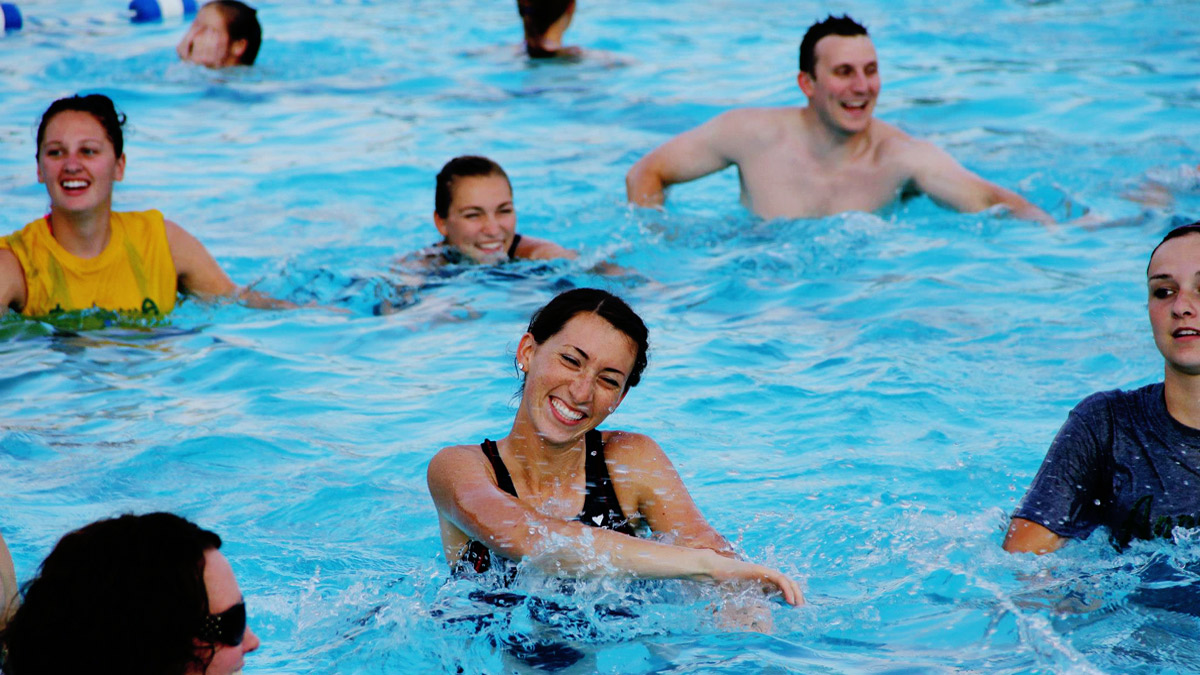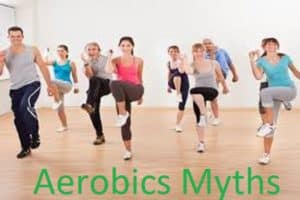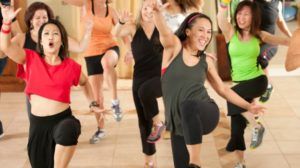Aerobics
Aerobics is a form of physical exercise that combines rhythmic aerobic exercise with stretching and strength training routines with the goal of improving all elements of fitness (flexibility, muscular strength, and cardio-vascular fitness). It is usually performed to music and may be practiced in a group setting led by an instructor (fitness professional), although it can be done solo and without musical accompaniment. With the goal of preventing illness and promoting physical fitness.
Aerobic exercise is any physical activity that makes you sweat, causes you to breathe harder, and gets your heart beating faster than at rest. It strengthens your heart and lungs and trains your cardiovascular system to manage and deliver oxygen more quickly and efficiently throughout your body. Aerobic exercise uses your large muscle groups, is rhythmic in nature, and can be maintained continuously for at least 10 minutes.
Common moves include:-
Basic Step
Corner knee (or corner kick)
Repeater knee (aka Triple knee)
T-Step
Over-the-Top
Lunges
V-Step
Straddle Down
L-Step
Split Step
I-Step

Like other forms of exercise, step aerobics helps burn calories and fat. The number of calories burned depends on the speed of movements, step height, length of exercise, and the person’s height and weight.
In addition to strengthening your heart and cardiovascular system, participation in regular aerobic exercise has many health benefits.

Benefits of Aerobics Exercise:-
Improves your circulation and helps your body use oxygen better
Increases energy
Increases endurance, which means you can work out longer without getting tired
Helps reduce the risk of developing heart disease
Helps reduce the risk of developing diabetes
Help reduce body fat
Helps you reach and maintain a healthy weight
Help reduce stress, tension, anxiety, and depression
Improves sleep
Immune System Boost
Mood enhancement
Increases Longevity
Greater Resistance to Fatigue
Improves Muscle health

Benefits of Aqua Aerobics:-
Low Impact on Joints
Great for those with balances issue
Decreased muscle soreness
Improves muscle endurance
Improves core strength
Keeps the body cool during exercise
It Burns an enormous amount of calories
Improves Flexibility
Fund and Enjoyable
Health benefits of aerobic are Cancer prevention, Cancer treatment, Osteoporosis, Depression, Diabetes, Cardiovascular disease, Obesity, and Weight Control.

Myths about aerobic Exercise:-
Myth #1 – “Fat Burning Zone” is a must to burn fat:- While there is such a thing as the “fat-burning zone”, most people do not understand the concept behind it. The misconception is that the body will burn a greater amount of fat during low-intensity aerobic exercise than it will during high-intensity aerobic exercise. In actuality, the body will burn a greater percentage of fat during low-intensity aerobic exercise than during high-intensity aerobic exercise. In addition, during higher-intensity aerobic exercise, you will burn more total calories and more fat calories than during low-intensity exercises.
Myth #2 – Exercise Is Worthless If I Can’t Do It Regularly for Hour :- there’s no silver bullet, and there’s no magic method to get in shape quickly, but there’s a great deal of new research that shows a healthy exercise regimen doesn’t mean spending hours at the gym every single day. Even 20 minutes per day can be all you need.
Myth #3 – You Need a Sports Drink When Exercising to Replenish Your Body’s electrolytes/Minerals/Etc :- For lower intensity or shorter duration exercise sports drinks are not needed. In fact, if you are exercising with the goal of losing weight, the calories in the sports drink you consume might offset the calories you burned during exercise! Those drinks are highly beneficial to the people who need them, and they have their place, but for most people doing moderate exercise, water will do.
Myth #4 – Stretching Before Exercise Will Prevent Injury :- This particular myth is contentious. There are pro and anti-stretching arguments, with staunch supporters on both sides, but the confusion about stretching comes down to the fact that many confuse “stretching” with “warming up.” It’s very important to warm up before strenuous exercise, and warming up can prevent injury, but stretching specifically has been shown to at best have little benefit. Make sure you warm up properly before you begin a workout.
Myth #5 – Working Out Will Only Build Muscle, Not Help Me Lose Weight :- This is a common misconception that just isn’t true. It is based partly on research that shows that people who try to lose weight by exercise only lose less weight than people who do diet only or diet + exercise. The reason for this is that is relatively easier to cut back on the calories you eat than it is to burn the same number of calories through exercise. When combined with diet, exercise can be a powerful combination to help you lose weight, but also live a healthier life.
Myth #6 – The only way to lose weight is to drastically cut back on calories :- Sure. If you drastically cut back on calories, you’ll lose weight, but results won’t be long-term. Not only is this type of extreme dieting nearly impossible to sustain, but it’s also unhealthy and can cause a number of health issues.
Myth #7 – Weight gain is inevitable as we age :- It’s true that it is more difficult to keep the weight from accumulating around our midsections as we age, but it is not impossible. By monitoring daily calories, eating primarily clean foods, exercising regularly, and participating in strength training, you can keep your trim physique for years to come.
Myth #8 – Don’t eat late at night :- Believe it or not, calories can’t tell time. Your body processes calories the same, no matter what time you eat them. The myth stems from the choices we usually make for late-night snacking—processed foods, or foods high in sugars and extra fat.
Myth #9 – Crunches will give you a flat stomach :- No amount of crunches will leave you with a 6-pack if you’ve got a layer of fat covering up those abdominal muscles. The only way to get that flat belly you’ve always dreamed of is with a combination of a healthy diet and exercise.
Myth #10 – If you’re eating healthy, you can eat as much as you want :- A calorie, is a calorie, is a calorie, no matter where it comes from. While it is much healthier for your body when you take in only nutritious, clean foods, eating too much of anything will still pack on the pounds.
Myth #11 – Diet foods help you diet :- Words like “low fat” or “low carb” don’t necessarily mean “low calorie”. “Diet” foods are often loaded with hidden dangers, like artificial sweeteners and preservatives. When tempted to go for diet versions of your favorite treats, it’s much better to go with a smaller portion of the real thing. It’ll taste much better, too!
Myth #12 – If you’re not sweating, you’re not working hard enough :- Perspiration does not dictate how hard you are working. Rather, it is a process the body uses to cool down. While sweating it out may feel great, it hardly gauges your caloric burn.
Myth #13 – Running on a treadmill is as effective as running outside :- Running against wind or on uneven terrain engages more of your muscles, requires more energy, and ends up burning more calories than running the same distance on a treadmill.
Myth #14 – You can’t work out when you are sick :- As long as you don’t have a fever and your symptoms are above the neck ( Stuffy nose or Sore throat ), you can totally hit the gym. Just listen to your body or ask your doctor if you are unsure.
Myth #15 – Crunches are the best moves for your core :- To really cinch your waistline, you are better off doing multi-muscle exercises that target every region of your core.
Myth #16 – Running beats walking :- Since running and walking target the same muscle group at different intensities they come with similar health results when you compare overall energy burn.
Simple Exercise for Aerobics
